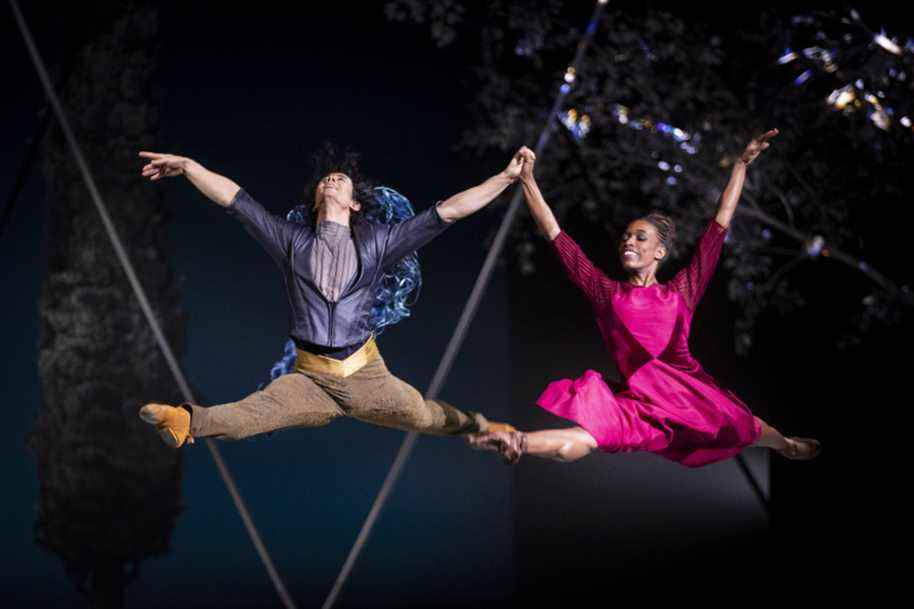Les Grands Ballets Canadiens return to the stage on a grand scale with the creation Romeo and Juliet, signed by the artistic director of the company, Ivan Cavallari. Fans of neoclassical narrative ballet will be served; those in search of audacity will remain unsatisfied.
Posted yesterday at 1:39 p.m.
In 2020, the National Ballet of Georgia was to present, at the invitation of Les Grands Ballets, its ballet Romeo and Juliet, one of William Shakespeare’s most iconic plays. The tragic story of the lovers of Verona, their passionate and impossible love, and the fatal rivalry between the Capulet and Montaigu families has seen many adaptations over the years, whether on stage or in cinema.
Then, the pandemic hit us, and, faced with the uncertainty as to the imminent arrival of a foreign troupe here, the artistic director of the Montreal company, Ivan Cavallari, decided to offer his own version of the famous story. To do this, he was inspired, yes, by Shakespeare’s play, but also drew on Italian literature from the 14and and 15and century, especially in the divine comedy of Dante. He therefore offers his very personal, quite intimate vision of Romeo and Juliet.

PHOTO SARAH MONGEAU-BIRKETT, THE PRESS
Les Grands Ballets invested a lot of time and money in making the costumes.
Major Production
For their big return to the stage, Les Grands Ballets probably wanted to please their audience with a large-scale production, bringing together the company’s 47 dancers wearing 140 handmade costumes — an investment of nearly $600,000 — on a stage magnified by life-size trees that will take on various colors throughout the scenes. All of this, without forgetting the Orchester des Grands Ballets, which is also making its return and performing live from the pit of Salle Wilfrid-Pelletier the famous music from the ballet composed by Sergueï Prokofiev.
In short, all the key elements are there — a tragic love story that has moved people for centuries, high-level performers, an imposing staging, captivating music — to hit the bull’s eye, create emotion, arouse passions. Unfortunately, the play does not quite achieve this.
The creation is not set in a particular era, with a strong desire to highlight the universality of this love story. Very good. But we are far from a timeless or minimalist aesthetic. On the contrary, there is here a sometimes dizzying and whimsical mix of references to various eras; the costumes, heterogeneous, mix colors, patterns, styles, textures. Scenic elements like (false) hairy dogs pulled by leashes are introduced, without us understanding exactly their contribution to the whole.
This proposal does not go off the beaten track, but should appeal to fans of the genre. The artistic director offers a fairly conventional neoclassical narrative ballet in its structure and choreographic language, a ballet-pantomime where danced scenes follow one another — in groups, in trios, in duets — telling the love story of Romeo and Juliet, but also other secondary characters such as the illicit relationship between Lady Montaigu and Lord Capulet.
Several paintings veer into the clownish and the burlesque, obviously to entertain and breathe a little lightness into the whole. The facial expressions and expressions are sometimes a little too emphatic, even if we smile at the antics of Mercutio, interpreted by a very fit Célestin Boutin, a character who will fall into the hands of Tybalt, Juliette’s cousin, causing the disastrous events that the we know.

PHOTO SARAH MONGEAU-BIRKETT, THE PRESS
Scene of the meeting between Romeo and Juliet
The fight scenes are generally well done and catchy, but some group scenes, especially early on, feel confusing, and the timing of the dancers isn’t always optimal. The scene of the meeting between Romeo and Juliet is cute, and the interpreters of the lovers, Kiara DeNae Felder and Hamilton Nieh, are very expressive, particularly the latter, who knows how to transmit emotion well. We also welcome the choice of performers from diverse backgrounds for these roles – which should no longer be an issue in 2022.
In the end, despite certain qualities, Les Grands Ballets offer a somewhat toned down version of Romeo and Juliet. We remain, after all, on the surface; a beautiful smooth surface that only scratches the rough, subterranean, dark side of this tragic love story, as it all ends with a final dance of lovers bathed in divine light, arms outstretched, gone live out their eternal love in the afterlife.
Until March 27, at Salle Wilfrid-Pelletier at Place des Arts.

